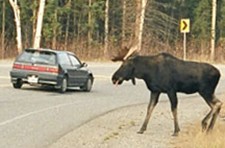Wildlife Collisions in Top 10 Crash Causes
Sunday, June 08, 2008 04:27 AM

submitted by Kathi Travers
One of my favorite thrills about living in PG is to drive up to Tyner Blvd and see a moose along the side of the road. They are such magnificent creatures.
(at right, moose attempts to cross University Way, Photo Courtesy Roy Rea)
However, a few weeks ago my joy turned to tears when I saw a moose being dragged off the road from a collision with an automobile. Over 17,000 animals perish every year in BC due to wildlife collisions. All too often, humans also get seriously hurt or perish as a result.
Wildlife collisions are among the top 10 factors in crashes in BC every year. In 2005, ICBC paid out in excess of $13 Million on more than 3,200 animal crashes in the North Central Interior region. “For every wildlife collision reported, three more go unreported" states Alyson Gourley-Cramer Regional Coordinator, Marketing and Communications, BC Interior of ICBC
People are just not paying attention to the roads. Speed is a big factor. Drivers see wildlife along the roads and still keep the speed up assuming the animals will not move. If you hold that opinion, changing it could save your life. You never know whether they will bolt across the road.
Wildlife is attracted to sides of the roads for several reasons. One is that it’s a windy area due to the speed of the vehicles passing by. Wind provides a relief from insects that plague the animals. Road salt is another attraction over the winter season. In the spring the ditches have new, lush grasses that make for good grazing. Another interesting factor is that wildlife shares the same travel corridors we use.
Collisions with wildlife occur more often on long stretches of road that offer good driving conditions,
RCMP Sgt Guy Tremblay of the Prince George Traffic Services urges drivers to "slow down and be cognizant to the fact that we live in an area with lots of wildlife. You should pay particular attention to early morning hours and dusk when the animals are more prevalent."
There are many signs posted, warning drivers to beware of wildlife. Keep your car in good working order. Your windshield, headlights and taillights should be kept clean. Use your high beams when safe there is not oncoming traffic. Keep your head lights properly aligned.
If you see one animal, chances are there are more as they often travel in groups. Slow down. Animals are unpredictable. When you are driving at night, have a buddy along with you so they can watch for wildlife. This could save your life and the life of our precious creatures of the forests.
There is a wonderful working group called The Wildlife Collision Prevention Program (WCPP) which was founded in 2001 in partnership between the British Columbia Conservation Foundation (BCCF) and the Insurance Corporation of British Columbia (ICBC). They research, evaluate and implement projects that will educate the public on good transportation safety practices effecting humans and wildlife. Check out their website at www.wildlifecollisions.ca
So, back to the big question: to swerve or not to swerve? You must try your best to not put yourself or your passengers at risk. If you swerve, you could either end up in a ditch, as my friend did, or drive right into oncoming traffic.
If you see a deer, your breaks would be the best solution. With a relatively light creature such as a deer and lower speed, it will lessen the effect of an impact.
In the case of a moose, according to WCPP, consider swerving if you feel a collision is imminent. As they state: "A collision with a moose, which can weigh up to 500 kg, carries a significant risk of injury or death to motorists and passengers. If a crash with a moose is inevitable, crouch as low as possible in your seat, or under the dash, as a moose's body usually ends up crushing the roof of a car completely flat."
Previous Story - Next Story
Return to Home










